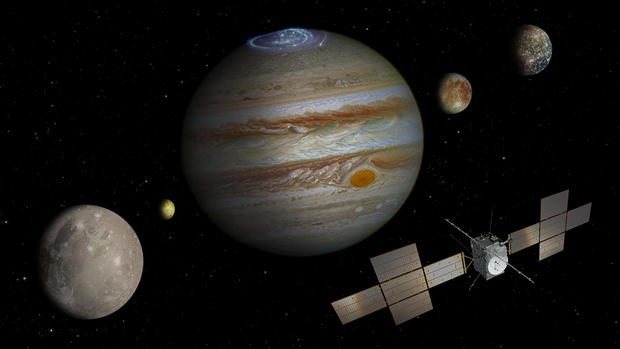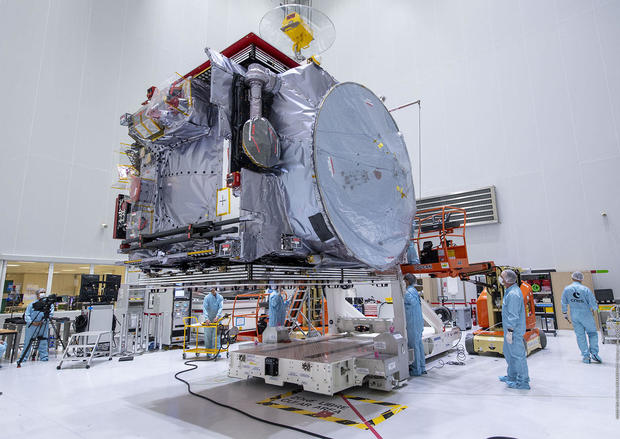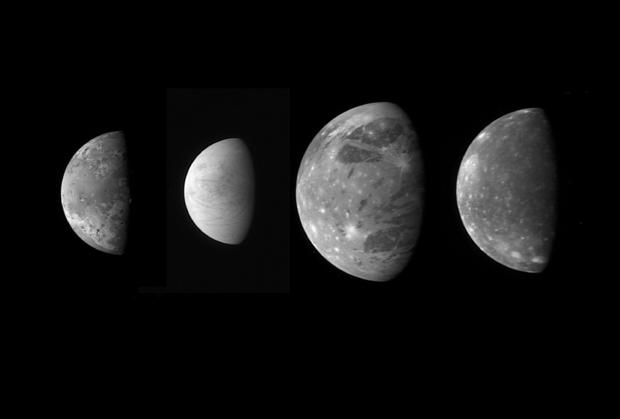Space probe to search for hints of hidden seas on Jupiter's frozen moons
An Ariane 5 rocket originally expected to launch Thursday is now set to take off Friday, boosting a $1.7 billion European Space Agency probe on a roundabout 8-year voyage to Jupiter where it will study the giant planet in exhaustive detail while focusing on three of its ice-covered moons where sub-surface, possibly habitable oceans are hidden from view.
"We'll explore Jupiter and its icy moons, which are Europa, Ganymede and Callisto with a particular focus on Ganymede, which is a unique object, the only moon with magnetic field and the biggest moon of the solar system," said European Space Agency project scientist Olivier Witasse. "The main goal is to understand whether there are habitable environments among those icy moons around a giant planet like like Jupiter."
The Jupiter Icy Moons Explorer — "JUICE" for short — will use ground-penetrating radar and other instruments to remotely probe the tidally-heated oceans thought to exist under the ice-locked crusts of Europa, Ganymede and Callisto. The spacecraft also will provide a fresh look at Io, the fourth moon discovered by Galileo in the early 1600s and the most volcanically active world in the solar system.
"We will characterize in particular the liquid water oceans which are inside the icy moons," Witasse said. "So the question is, where are those oceans located? At what distance underneath the surface of the moons? What is the depth of this ocean? How much water do we have? What is the composition of this water?
"And to understand this question of habitability, we need to explore the Jupiter system globally. So (JUICE will) study Jupiter, its atmosphere, its weather, its strong, rotating magnetic field, the volcanic moon Io, the other moons in the system and how all these bodies are connected to each other."
Delayed by stormy weather, JUICE's journey begins Friday at 8:14 a.m. EDT when the Ariane 5, the same rocket used to launch the James Webb Space Telescope on Christmas Day 2021, blasts off from the European Space Agency's launch site in Kourou, French Guiana, weather permitting.
The Ariane 5 does not have enough power to propel the 6.5-ton JUICE directly to its target. Instead, it will send the spacecraft on a 3.1-billion-mile interplanetary bank shot carrying it once past the Earth and moon in August 2024, once past Venus in August 2025 and then twice more by Earth in 2026 and 2029. The slingshot-like gravity-assist flybys will pump up the velocity enough to finally head for Jupiter.
"The gravity assists have to be precise, but we have very capable people in mission control and they're accustomed to these maneuvers," said payload system engineer Alessandro Atzei. "The first one will be very challenging because ... we have to pass by Earth and the moon at the same time. So this will be the most accurate gravity assist maneuver ever done."
Even with all that, it will still take eight years before JUICE reaches Jupiter in July 2031.
NASA's Europa Clipper spacecraft, launching in October 2024, will beat JUICE to Jupiter by about a year, arriving in orbit in April 2030, thanks to the power of its SpaceX Falcon Heavy rocket. But the two missions are not in competition.
As its name suggests, NASA's probe will focus on Europa, flying past that icy moon nearly 50 times at altitudes as low as 16 miles. JUICE will focus primarily on Callisto and Ganymede, making 21 flybys of the former and 12 of the latter.
JUICE will spend the last nine months of its four-year exploration of Jupiter in orbit around Ganymede, the first spacecraft to orbit a moon of another planet. Once out of fuel, it will be directed to crash into the surface.
As for Clipper, "we are very happy that there will be two spacecraft at the same time in the Jupiter system," Witasse said. "So for the science outcome, it will be just fantastic and very exciting. We are working very closely with the Clipper teams. ... The great thing is that the two missions are very complementary."
Jupiter is second only to Mars as the most visited planet in the solar system.
NASA's Pioneers 10 and 11, Voyagers 1 and 2, the NASA-ESA Ulysses sun-study probe, the Cassini Saturn orbiter and the New Horizons mission to Pluto all flew past Jupiter for quick-look observations. NASA's Galileo probe orbited the giant planet from 1995 to 2003 and the agency's Juno probe is currently in orbit carrying out extensive studies of Jupiter's atmosphere, its interior and its powerful magnetic fields, with occasional flybys of major moons.
Several of those missions were able to detect hints of sub-surface seas on Europa, Callisto and Ganymede using a variety of subtle techniques. The heat needed to sustain liquid water on such otherwise frozen worlds is thought to come from tidal stresses induced by Jupiter's titanic gravity as the moons wheel about in slightly elliptical orbits.
JUICE and Clipper will open new windows on those icy worlds, possibly confirming the habitability of the hidden seas. Whether life could exist in such extreme environments is an open question.
"We will (initially) focus on Europa, then we will go to a high latitude phase, which is basically focusing more of the polar areas of Jupiter itself," said Atzei. "And then we will transfer to Ganymede, where the mission will end in about four years, depending on how much propellant we have left, in a circular orbit. When the propellant is finished, or nearly finished, we will have a controlled crash on Ganymede."
JUICE is carrying 10 sophisticated instruments, including a laser altimeter and radar capable of peering nearly six miles below the surface of the targeted moons. Other instruments will study the charged particle environment in the Jupiter system while high-resolution cameras will image the moons across multiple wavelengths to determine the chemical composition of the surfaces below and to search for possible water plumes spewing into space.
The spacecraft's radio signals will be precisely monitored on Earth to determine how the gravity of Jupiter and the moons affect the probe's trajectory, providing additional clues about the density and structure of the moons. ESA says the 10 instruments, radio experiment and radiation sensors represent "the most powerful remote sensing, geophysical and in situ payloads ever flown to the outer solar system."
But, Witasse cautions, "we are not going to detect life with JUICE. Nevertheless, we are going to study interesting aspects related to life and habitability."
An ion mass spectrometer will be able to detect "many, many molecules, not only water vapor, but also other kinds of molecules" in the very tenuous atmospheres around the moons and other instruments will measure the vertical profile of the atmospheric constituents, densities and temperatures, along with visible and infrared mass spectrometer readings of their composition.
"If I want an objective to highlight," Witasse said, "it's quite fascinating to think that underneath the surface, this icy surface that we can see in images, there is a lot of liquid water. And that will be really the most interesting aspect of of the mission, to know where is this water? What is the composition in terms of salt? How does that relate to the habitability of those moons?"
To power its instruments, propulsion systems, heaters, navigation and computer equipment, JUICE is equipped with two huge solar panels covering 915 square feet. The large arrays are required because of Jupiter's distance from the sun, which averages 484 million miles. Even so, by the end of JUICE's primary mission, degradation in the harsh radiation environment around Jupiter is expected to reduce the output of the arrays to just 800 watts, roughly equivalent to the power needed by a hair dryer.
ESA and spacecraft-builder Airbus went to great lengths to ensure JUICE's flight computer, equipped with 1 terabyte of memory, is protected from that radiation, sealing it inside a lead-lined vault.
"The radiation is is a killer for the electronics and unless you protect it," said Justin Byrne, head of science programs at Airbus. "Basically, the electronics will start failing, we would have memory corruptions and then catastrophic failure of the computers eventually."
As for the rest of the probe's systems, "the spacecraft is fully redundant, so there are two computers, there's two of everything," he said. "A lot of the work on the JUICE mission was to prove that in any scenario, any failure, the spacecraft could autonomously reconfigure itself and not put itself into any jeopardy."








